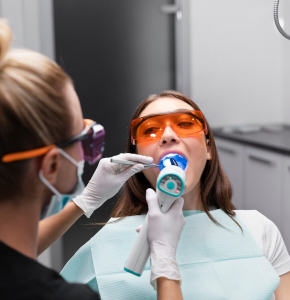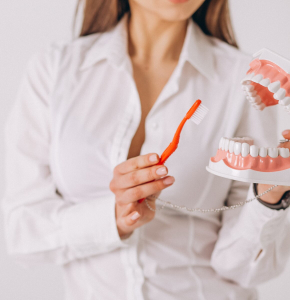Removable Prosthetics
Description of procedure
Partial dentures are fabricated when teeth are missing and implantation is not possible.
- Clasp dentures: These prosthetics feature a metal framework onto which artificial gums and teeth are mounted. They are secured in the mouth by special hooks (clasps) or locks, which are often noticeable. Clasp dentures are known for their reliability and durability, with a service life of up to 10 years.
- Acrylic dentures: Artificial teeth and gums are made of polymer plastic and are retained on supporting teeth with clasps. This is the most popular and inexpensive type of denture, but it is not long-lasting (with a service life of about 3 years) and has many drawbacks.
- Nylon dentures are made from a special dental nylon that is semi-transparent and closely matches the natural shade. Such dentures are also attached to teeth using nylon, making them almost invisible in the mouth. Despite their aesthetic advantages and comfort in wearing, nylon dentures have a significant drawback. The use of such flexible dentures leads to improper redistribution of chewing load on the bone tissue of the jaws, resulting in rapid atrophy.
- Quattro Ti: This type is very similar to clasp dentures, but the framework and clasps are made of hypoallergenic and durable polymer material.
Full dentures:
Full removable dentures are used when all teeth are lost in one or both jaws. They completely recreate the dental arch, improve appearance, partially restore chewing function, and speech. Acrylic and nylon removable dentures are used in cases of total tooth loss.

Indications for removable prosthodontics:
– Complete or partial loss of teeth – Need for restoration of chewing function – Improvement of facial aesthetics and diction
Contraindications:
– Diseases of the oral mucosa – Pronounced atrophy of bone tissue – Anatomical features of the oral cavity – General diseases – Allergy to materials used – Bruxism
Drawbacks of removable prosthodontics:
- It should be noted that with prolonged use of removable dentures, significant atrophy of the bone tissue occurs. Bone loss can reach up to 3 mm per year. At such rates, it becomes impossible to perform implantation without additional bone tissue restoration surgery after 5 years.
- Due to constant bone atrophy, there is a change in the prosthetic bed, necessitating frequent prosthesis adjustments.
- Long adaptation period and incomplete restoration of chewing function.
Installation of removable Prosthetics at LAMA Dentistry in Warsaw



Manufacturing process:
1. Consultation and diagnosis
2. Taking impressions of the upper and lower jaws
3. Prosthesis fabrication in the dental laboratory, taking into account your individual parameters and requirements
4. Prosthesis fitting
5. Final appointment with consultation on care and recommendations for use
Let the team of specialists at LAMA Dentistry in Warsaw help you restore your confidence and comfort.
Lama Dentistry is a treatment that brings results




























